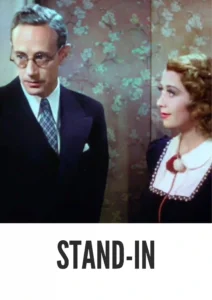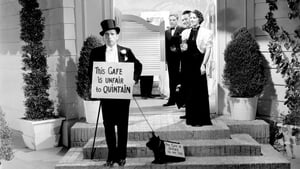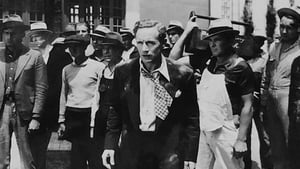Video Sources 0 Views
- Stand-In 1937 Colorized


Synopsis
Table of Contents
ToggleHollywood Scandals and Hilarious Mishaps: Stand-In (1937) in Vibrant Color

Step back into the Golden Age of Hollywood with Stand-In, a delightful screwball comedy from 1937, now beautifully colorized for a modern audience. Starring Joan Blondell and Humphrey Bogart, this film offers a witty and charming look at the inner workings of a major movie studio. Perfect for fans of classic comedies and those who love a peek behind the scenes, this HD download brings a sparkling piece of cinematic history to your screen. The movie was also released under the title Girl in Distress.
Stand-In Storyline: Saving Colossal Studios from Disaster
Stand-In tells the story of Lester Plum (Leslie Howard), a brilliant but naive mathematician who is sent to Hollywood to analyze the financial woes of Colossal Studios. Once there, he discovers the studio is on the brink of collapse due to mismanagement and extravagant spending.To save the studio, Lester teams up with Sally (Joan Blondell), a former child star turned stand-in, and Doug (Humphrey Bogart), a disgruntled screenwriter. Together, they navigate the chaotic world of filmmaking, battling temperamental stars, greedy executives, and ridiculous movie productions. Through a series of hilarious mishaps and clever schemes, they attempt to bring Colossal Studios back from the brink and restore sanity to the movie-making process. Stand-In is a fast-paced and entertaining comedy that celebrates the magic and madness of Hollywood’s Golden Age.
Movie Cast
The film features a stellar cast of actors who bring this comedic story to life:
- Leslie Howard as Lester Plum
- Joan Blondell as Sally
- Humphrey Bogart as Doug
- Alan Mowbray as Director Kosloffski
- Marla Shelton as Thelma
Movie Genre
Stand-In falls squarely into the genre of screwball comedy, with its fast-paced dialogue, zany characters, and improbable situations. Its witty humor and lighthearted tone make it a delightful and entertaining film for audiences of all ages.
Historical Context: Hollywood’s Golden Age
Released in 1937, Stand-In offers a humorous commentary on the inner workings of Hollywood during its Golden Age. The film reflects the industry’s glamour, extravagance, and occasional absurdity, providing a behind-the-scenes look at the movie-making process. During this period, Hollywood was at its peak, producing countless classic films that continue to captivate audiences today. Stand-In captures the spirit of this era with its witty dialogue, memorable characters, and charming depiction of studio life.
Colorization Details
This colorized version of Stand-In has been carefully restored using modern digital techniques, enhancing the visual appeal while preserving the film’s original charm and humor. The colorization process involved analyzing the grayscale tones of the original black and white footage and assigning appropriate colors to each scene. Advanced algorithms were used for color palette selection and image enhancement. This meticulous process brings new life to the characters and settings, making the story even more engaging for modern audiences. While the choice to colorize classic films can be debated, it introduces these films to a broader audience, ensuring their legacy for future generations.
Technical Details
- Director: Tay Garnett
- Screenplay: Gene Towne, Graham Baker
- Story: Clarence Budington Kelland
- Cinematography: Merritt B. Gerstad
- Edited by: Otto Brower
- Production Company: Edward Small Productions
- Distributed by: United Artists
- Runtime: 91 minutes
Technical Specifications
- Download Format: MP4
- Resolution: HD (1080p)
- Compatibility: Compatible with most devices, including smartphones, tablets, computers, and smart TVs.
Reviews and Critical Reception
Stand-In (1937) is celebrated for its witty humor, charming performances, and insightful commentary on Hollywood’s Golden Age. The film offers a delightful blend of comedy and satire, providing a behind-the-scenes look at the movie-making process. As a classic screwball comedy, Stand-In remains a beloved and entertaining film for audiences of all ages.
FAQs
- Q: What is Stand-In about?
- A: Stand-In is a screwball comedy about a mathematician who goes to Hollywood to save a struggling movie studio.
- Q: Is Stand-In (1937) a well-known classic film?
- A: Stand-In is a celebrated screwball comedy known for its witty humor and charming performances.
- Q: Is this version of Stand-In colorized?
- A: Yes, this version has been professionally colorized to enhance the viewing experience.
- Q: What makes Stand-In interesting for classic film fans?
- A: Stand-In offers a humorous and insightful look at Hollywood’s Golden Age, with memorable characters and witty dialogue.
- Q: What is the download format?
- A: The download format is MP4, which is compatible with most devices.
- Q: What resolution is the download?
- A: The resolution is HD (1080p), providing a high-quality viewing experience.
Download Now in HD!
Watch Stand-In Today!












